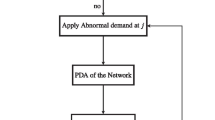Abstract
Pipe failure often occurs in water distribution networks (WDNs) and results in high levels of water loss and socio-economic damage. Physical-based, statistical and data-driven models have been developed to estimate pipe failure rates (failures per km of pipe per year) to efficiently manage water losses from WDNs and to ensure safe operations. Due to the complexities of pipe failure patterns, we develop a superposed statistical model to depict the relationship between pipe failure rate and pipe age. The model’s level of uncertainty was then quantified by simulating pipe failures as Poisson numbers. Part of Beijing’s WDN is taken as a study case, and pipe failure data for a 4-year period, as well as pipe properties, are collected to develop the pipe failure model. The case study results show that the pipe failure rates vary with time in a non-monotonic manner and that the proposed model captures pipe failure behaviour with an R2 value of 0.95. A 95% confidence interval of modelled pipe failures for each pipe age group is used to describe the uncertainty level of the model. We find that 88% of the observations fall under the 95% confidence interval. The established model could be applied to prioritize pipes with higher failure rates to optimize pipe replacement/rehabilitation strategies. Our uncertainty analysis of this model can help utility managers understand the model’s reliability and formulate reasonable WDN management plans.





Similar content being viewed by others
References
Andreou SA, Marks DH, Clark RM (1987) A new methodology for modelling failure patterns in deteriorating water distribution systems: Theory. Adv Water Resour 10(1):2–10
Araujo LS, Ramos H, Coelho ST (2006) Pressure control for leakage minimisation in water distribution systems management. Water Resour Manag 20(1):133–149
Berardi L, Kapelan Z, Giustolisi O, Savic D (2008) Development of pipe deterioration models for water distribution systems using EPR. J Hydroinf 10(3):113–126
Constantine AG, Darroch JN, Miller R (1996) Predicting underground pipe failure. Water (J Austra Water Assoc) 23(2):9–10
Haight FA (1967) Handbook of the Poisson distribution. John Wiley & Sons, New York
Ho CI, Lin MD, Lo SL (2010) Use of a GIS-based hybrid artificial neural network to prioritize the order of pipe replacement in a water distribution network. Environ Monit Assess 166(1):177–189
Jafar R, Shahrour I, Juran I (2010) Application of artificial neural networks (ANN) to model the failure of urban water mains. Math Comput Model 51(9–10):1170–1180
Karadirek IE, Kara S, Yilmaz G, Muhammetoglu A, Muhammetoglu H (2012) Implementation of hydraulic modelling for water-loss reduction through pressure management. Water Resour Manag 26(9):2555–2568
Kettler AJ, Goulter IC (1985) An analysis of pipe failure age in urban water distribution networks. Can J Civ Eng 12(2):286–293
Kleiner Y, Rajani B (2001) Comprehensive review of structural deterioration of water mains: statistical models. Urban Water 3(3):131–150
Le Gat Y, Eisenbeis P (2000) Using maintenance records to forecast failures in water networks. Urban Water 2(3):173–181
Li ZJ, Chen QW, Xu Q, Blanckaert K (2013) Generalized likelihood uncertainty estimation method in uncertainty analysis of numerical eutrophication models: Take BLOOM as an example. Math Probl Eng. https://doi.org/10.1155/2013/701923
Lindenschmidt KE, Fleischbein K, Baborowski M (2007) Structural uncertainty in a river water quality modelling system. Ecol Model 204(3):289–300
Lu YH, Huang ZJ, Zhang T (2013) Method and case study of quantitative uncertainty analysis in building energy consumption inventories. Energ Buildings 57:193–198
Mailhot A, Pelletier G, Noel JF, Villeneuve JP (2000) Modeling the evolution of the structural state of water pipe networks with brief recorded pipe failure histories: Methodology and application. Water Resour Res 36(10):3053–3062
Mannina G, Viviani G (2010) An urban drainage stormwater quality model: Model development and uncertainty quantification. J Hydrol 381(3–4):248–265
Pulcini G (2001) Modeling the failure data of a repairable equipment with bathtub type failure intensity. Reliab Eng Syst Saf 71(2):209–218
Rajani B, Kleiner Y (2001) Comprehensive review of structural deterioration of water mains: physically based models. Urban Water 3(3):151–164
Shamir U, Howard C (1979) An analytical approach to scheduling pipe replacement. J AWWA 71(5):248–258
Shen ZY, Hong Q, Yu H, Liu RM (2008) Parameter uncertainty analysis of the non-point source pollution in the Daning River watershed of the Three Gorges Reservoir Region, China. Sci Total Environ 405(1):195–205
Singh A, Adachi S (2013) Bathtub curves and pipe prioritization based on failure rate. Built Environ Proj Asset Manage 3(1):105–122
Watson TG, Christian CD, Mason AJ, Smith MH, Meyer R (2004) Bayesian-based pipe failure model. J Hydroinf 6(4):259–264
Wilkins DJ (2002) The bathtub curve and product failure behavior part one - The bathtub curve, infant mortality and burn-in. Reliab HotWire. No. 21. http://www.weibull.com/hotwire/issue21/hottopics21.htm
Xu Q, Chen QW, Li WF, Ma JF (2011) Pipe failure prediction based on evolutionary data-driven methods with brief recorded data. Reliab Eng Syst Saf 96(8):942–948
Xu Q, Chen QW, Ma JF, Blanckaert K (2013) Optimal pipe replacement strategy based on break rate prediction through genetic programming for water distribution network. J Hydro-environ Res 7:134–140
Acknowledgements
This work was supported by Ministry of Science and Technology of People’s Republic of China (2017ZX07108-002) and by the Jiangsu Science Fund (BE2016617, GHB-HT-2016).
Author information
Authors and Affiliations
Corresponding author
Rights and permissions
About this article
Cite this article
Xu, Q., Qiang, Z., Chen, Q. et al. A Superposed Model for the Pipe Failure Assessment of Water Distribution Networks and Uncertainty Analysis: A Case Study. Water Resour Manage 32, 1713–1723 (2018). https://doi.org/10.1007/s11269-017-1899-8
Received:
Accepted:
Published:
Issue Date:
DOI: https://doi.org/10.1007/s11269-017-1899-8




